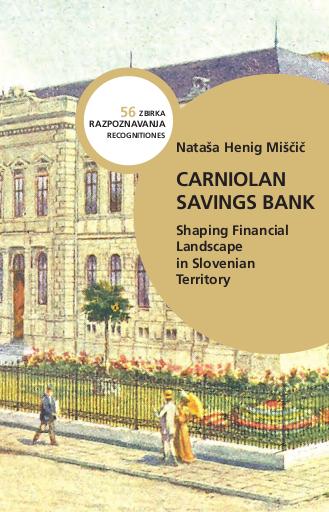/
Literature
/
Monographs
Carniolan savings bank
Shaping financial landscape in Slovenian territory


This work by Nataša Henig Miščič is licensed under Creative Commons Attribution-NoDerivs 4.0 International
Files (1)

Description
The book examines the historical significance and development of financial intermediation on Slovenian territory, with a focus on the Carniolan Savings Bank in Ljubljana, which was established in the early 19th century. Savings banks were financial institutions that emerged in the early 19th century. Their primary purpose was to collect money or savings deposits from the lower but captive classes of the population. These institutions were founded to encourage savings among the less affluent, promote thrift and financial inclusion, and ultimately contribute to local and regional economic growth. The study outlines the context in which savings banks emerged. It emphasises their role in capital formation and economic development when the financial needs of the lower classes were largely unmet. Motivated by a combination of Enlightenment principles and monetary incentives, the founders of the Carniolan Savings Bank created a financial institution to encourage the population of Carniola Province to save and invest.
Metadata (14)
- identifierhttps://hdl.handle.net/11686/71213
- title
- Carniolan savings bank
- Shaping financial landscape in Slovenian territory
- creator
- Nataša Henig Miščič
- contributor
- Nives Kokeza (lekt.)
- Andreja Jezernik (lekt.)
- Aleksander Lorenčič (rec.)
- Peter Vodopivec (rec.)
- subject
- Kranjska hranilnica
- Kranjska
- Habsburška monarhija
- gospodarstvo
- description
- Knjiga obravnava zgodovinski pomen in razvoj finančnega posredništva na slovenskem ozemlju. V ospredju se nahaja Kranjska hranilnica, ki je bila ustanovljena v Ljubljani leta 1820. Hranilnice so bile finančne ustanove, ki so se pojavile v začetku 19. stoletja. Njihov primarni namen je bil zbiranje denarja oziroma hranilnih vlog od nižjih slojev prebivalstva. Te ustanove so delovale s ciljem, da bi spodbujale varčevanje med manj premožnimi sloji prebivalstva in pospeševale ideje o pomenu varčnosti in finančne vključenosti ter navsezadnje prispevale k lokalni in regionalni gospodarski rasti. Študija obravnava kontekst, v katerem so se hranilnice pojavile, poudarja njihovo vlogo pri vključevanju prebivalstva, ki do takrat ni imel pristopa do bančnih storitev. Voditelji Kranjske hranilnice so bili še vedno pod vplivom idej razsvetljenstva in so ustanovili finančno ustanovo, ki je motivirala varčevanje prebivalstva na Kranjskem.
- The book examines the historical significance and development of financial intermediation on Slovenian territory, with a focus on the Carniolan Savings Bank in Ljubljana, which was established in the early 19th century. Savings banks were financial institutions that emerged in the early 19th century. Their primary purpose was to collect money or savings deposits from the lower but captive classes of the population. These institutions were founded to encourage savings among the less affluent, promote thrift and financial inclusion, and ultimately contribute to local and regional economic growth. The study outlines the context in which savings banks emerged. It emphasises their role in capital formation and economic development when the financial needs of the lower classes were largely unmet. Motivated by a combination of Enlightenment principles and monetary incentives, the founders of the Carniolan Savings Bank created a financial institution to encourage the population of Carniola Province to save and invest.
- publisher
- Založba Inštituta za novejšo zgodovino
- collection
- Razpoznavanja ; 56
- date
- 2025
- type
- besedilo
- identifier
- COBISS-ID: 253108995
- language
- Angleščina
- rights
- license: ccByNd
- fileResource
